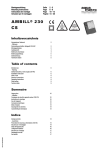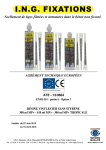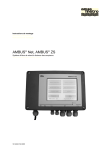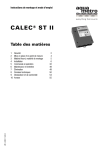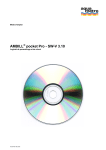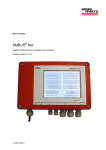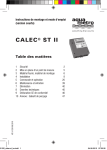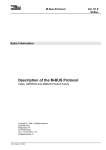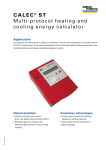Download Aqua-Hot AHE-200-02S-24 VDC Operating instructions
Transcript
Installation and operating instructions CALEC ® energy master The benchmark for energy measurement technology Short version Firmware Version 1.00 VD 3-135 e, 07.2009 1 Contents 1 Contents 2 2 Information and references 3 3 16 16 3 9.2 Display 9.2.1 Key functions 16 17 Safety notices 4 9.3 Right of access, security levels 17 3.1 Symbols used 4 3.2 Intended use 4 10.1 Main display and main menu 18 3.3 Inappropriate use 4 10.2 Submenus 19 3.4 Installation guidelines 5 3 2.2 Documents View of device with protective housing 5 View of device without protective housing (Mod) 7 6 Mounting the device with protective housing (Prot) 8 Operation 9.1 PC-Software AMBUS Win II 2.1 Information 4 7 9 6 8 6.1 Scope of supply, tools and mounting material (Prot) 8 6.2 Installation (Prot) 8 Mounting the device without protective housing (Mod) 12 7.1.1 Rail mounting 12 7.1.2 Connecting to mains power supply 230 VAC 12 7.1.3 Connecting to low voltage supply 24 VDC 13 7.1.4 Connecting signal cables 13 Electrical connections 10 Menu overview 18 11 Use under operating conditions 21 11.1 The main display 21 11.2 The measured values submenu 11.2.1 Measured values 11.2.2 Meter readings 11.2.3 Current values 11.2.4 Billing date values 11.2.5 Logger values 22 22 22 22 22 22 12 Dimensional drawings and technical specifications 23 12.1 Drawings of device with protective housing (Prot) 23 12.2 Drawings of device without protective housing (Mod) 23 12.3 Technical specifications 25 13 EC declaration of conformity 28 14 8.1 Connection instructions 14 8.2 Wiring diagram, module and signal numbers 14 8.3 Numbering rules 15 CALEC® energy master installation and operating instructions 2 2 Information and references 2.1 Information These installation and operating instructions describe the installation and commissioning of a standard device. The chapters describe the topics and tasks in the sequence in which they are needed during commissioning. • • • • • • • Safety instructions Information about the device Installation Electrical connections Operation Fault clearance Technical data Always comply with the safety instructions. 2.2 Documents The installation and operating instructions VD 3-135 vary in scope, depending on the version and items covered by the delivery. The information required for ancillary modules and optional functions is described in additional document extracts (VD 3-136). Parameterisation software AMBUS Win II The parameterisation software AMBUS Win II is available for setting the parameters. It can be downloaded free of charge (see below). Downloads The current documents and AMBUS Win II are available as free downloads at www.aquametro.com /downloads. CALEC® energy master installation and operating instructions 3 3 Safety notices 3.1 Symbols used Important information Non-observance can lead to malfunction. General warning Non-observance can lead to damage or malfunction. Warning of dangerous electric voltage Non-observance can lead to physical injury! 3.2 Intended use The device is used as an energy calculator for heating, cooling and air conditioning applications in district heating or cooling, in building management services and in industrial energy metering. It is part of a combined heating/cooling or air conditioning meter, consisting of a calculator, a pair of temperature sensors and a flow meter, or as a transducer for a flow meter. The environmental conditions described in the technical specifications, as well as the installation and operating instructions must be complied with. 3.3 Inappropriate use The device must not be used: • • • • • In explosion-risk zones (no ex-risk protection!) In a wet environment (condensing, splashing or dripping water) Outdoors, without suitable protection In environmental conditions (temperature, humidity, vibrations, electromagnetic interference etc.) that do not comply with the technical specifications In all other instances that do not conform to its intended use The device can be dangerous if it is not used as intended, or not in accordance with the installation and operating instructions. In order to avoid this, it is essential that the safety instructions, operating conditions (see technical specifications) and the relevant chapters of these instructions are strictly adhered to. The manufacturer accepts no liability for damage arising from inappropriate use. 4 CALEC® energy master installation and operating 3.4 Installation guidelines The installation should be performed by authorised, skilled personnel, in compliance with the regulations in force (EN1434 part 6 Regulations and recommendations for installation and operation) and the recommendations of the industry-specific associations (e.g. the AGFW series of leaflets on district heating supplies). The skilled personnel must have read and understood these instructions. The requirements in the instructions and the applicable regulations on electrical installations must always be observed. Work on electrical circuits with hazardous voltages (> 24 VAC or >42 VDC) may only be carried out by authorised, skilled people, in compliance with the locally applicable regulations! CALEC® energy master installation and operating instructions 5 4 View of device with protective housing Device with closed protective housing 1 Housing cover 2 Operating keys 3 Dot-matrix LCD 4 Type plate with CE marking 5 IR interface on display module (EN13757-2 / -3 M-Bus) IrDA interface on CPU module 6 Housing screws, covered by security sealing caps Device with opened protective housing 2 Operating keys 3 Display, LCD dot matrix 5 IR interface (EN13757-2 / -3 M-Bus) IrDA interface 7 Display module 8a Upper terminals, plug-in 8b Lower terminals, plug-in 9 Clip-on holder for modules 10 3 Fastening holes for wall mounting 11 Clip-on holder for rail mounting 12 Strain relief 13 Cover hinges The wiring diagram is on the inside of the housing cover. View of the protective housing from below 11 14 15 16 6 Clip for rail Cable duct supply 14 mm Cable ducts 10 mm Cable ducts 14 mm CALEC® energy master installation and operating 5 View of device without protective housing (Mod) The following diagram shows the device without protective housing. 2 Operating keys 3 Display, LCD dot matrix 5 IR interface (EN13757-2 / -3 M-Bus) IrDA interface 7 Display module 8a Upper terminals, plug-in 8b Lower terminals, plug-in 9 Clip-on holder for modules The Display can be installed at a remote location e.g. in a control panel by using the two Remote Display Adapters: 11 11 Remote Display Adapter RDA/CPU 12 Remote Display Adapter RDA/Display 13 Network cable 12 13 CALEC® energy master installation and operating instructions 7 6 Mounting the device with protective housing (Prot) 6.1 Scope of supply, tools and mounting material (Prot) Warning! Precision measuring devices! Protect against heat, humidity, dirt and vibration. Only unpack the device when ready to install. Non-observance can result in damage or malfunction. • One Installation and Operating Instructions manual 1) Support rail optional 6.2 Installation (Prot) Opening the housing 8 CALEC® energy master installation and operating Mounting on support rail (DIN-EN 50222) Choose the location for installation • which is protected against humidity, heat, direct sunlight and damage • with easy access for reading, operation and installation • with sufficient distance from sources of electromagnetic interference 1. Drill holes 2. Screw on support rail 3. Clip device onto support rail Wall mounting Remove clip-on holder to get a stable support. Only mount device on a flat surface! CALEC® energy master installation and operating instructions 9 Wiring diagram The wiring diagram is on the inside of the housing cover. Connecting to mains power supply 100 - 240 VAC The mains supply must be connected via a two-pole separator and be adequately protected against unauthorised interruption. The mains supply 100 - 240 VAC may only be connected to the following terminals: Terminals L, N (supply module) Terminals 110, 115 (relay module 2x240 VAC) The device must be protected by a 10 AT external fuse. The device is fully isolated and requires no grounding connections. Connection to other terminals is extremely dangerous and can permanently damage the instrument! Connecting to low voltage supply 24 VDC 10 CALEC® energy master installation and operating Connecting signal cables 1. Pierce sealing membrane with enclosed awl 2. Insert cable 3. Attach cable to terminal screws according to wiring diagram on the inside cover 4. Affix strain relief clamp Closing housing 1. Insert the cover into the hinge from above and turn to close 2. Tighten the two fixing screws 3. Engage the security sealing caps with the smooth side on the outside. Once the caps e have been fitted, any unauthorised opening of the device can be detected. Removing the caps: Insert a pointed tool and lever out. The cap is damaged as a result and must be replaced. CALEC® energy master installation and operating instructions 11 7 Mounting the device without protective housing (Mod) 7.1.1 Rail mounting 1. Drill fastening holes 2. Screw on support rail 3. Clip modules onto support rail 7.1.2 Connecting to mains power supply 230 VAC Refer to the wiring diagram before starting wiring! The mains supply may only be connected to terminals L and N! The device is fully isolated and requires no grounding connections. All other terminals are only for low voltage (<50 V) and measuring signals. Connection to these terminals is extremely dangerous and can permanently damage the instrument! 1. Strip the power cable as shown in drawing. 2. Connect power cable to supply module (see enclosed wiring diagram) 12 CALEC® energy master installation and operating 7.1.3 Connecting to low voltage supply 24 VDC 1. Strip cable as shown in drawing 2. Attach cable to the connect module (see enclosed wiring diagram) 7.1.4 Connecting signal cables 1. Attach signal cables to terminal screws according to enclosed wiring diagram 2. The terminal blocks can be plugged in. CALEC® energy master installation and operating instructions 13 8 Electrical connections 8.1 Connection instructions Devices with 100 - 240 VAC connections must have a safety fuse with a max. 10 AT, and must be capable of being made voltage-free by means of an isolating element! The device must be connected to the same electric circuit and the same fusing, switching and isolating elements as the corresponding heating or cooling system. If the device is additionally connected via fusing, switching and isolating elements, then these must be protected against unauthorised access (e.g. by security seals), so that the device cannot be put out of operation by unauthorised persons. 8.2 Wiring diagram, module and signal numbers Below are two examples of wiring diagrams in which the module numbers and signal numbers or signal designations are shown: Basic unit with 3 modules (right to left): M-101-Prot-AC[I]-CT • CPU module 2 x Pt100 • Input module for flow signal • Mains power supply (supply module) • CPU module 2 x Pt100 • Input module for flow signal • 2 output modules for 4 analogue output signals, e.g. for a building services management system • 2 M-Bus modules for data reading with 2 M-Bus master units • Mains power supply (supply module) • Designation: • Module numbers • Signal designation according to standard diagram of the application • Designation: • Signal numbers, without signal designation • Signal designation according to the standard diagram of the application Input CPU M-Bus M-Bus Output Output Input CPU Modul 2 Modul 1 Modul 6 Modul 5 Modul 4 Modul 3 Modul 2 Modul 1 Qv, Qv1 Th Schnittst.2 Schnittst.1 Ausgang 3 Ausgang 1 Eingang 1 Pt100 1 Qv2, STA Tc Ausgang 4 Ausgang 2 Eingang 2 Pt100 2 Note on input module: 14 Fully assembled unit with 7 modules (right to left): EM-101-Prot-AC[MMOOI]-CT Left-hand pair of terminals: Right-hand pair of terminals: Power via calculator External supply CALEC® energy master installation and operating 8.3 Numbering rules Basic rule: The signals are numbered from right to left and from the top down. This table shows the elements that have a number, and their maximum number. Element Module Display/number Mod-No.1… 6 (Prot) * Mod-No.1…15 (Mod) * Explanation Numbers according to assembly from right to left No. 1 is the CPU module The module for power supply has no number Input Input 1…8 Pulse, current or frequency signal Pt100 input Pt100 No.1…6 Pt100 inputs for temperature measurement Output Output 1…8 (Prot) * Output 1…12 (Mod) Output 1 …8, (short designation e.g. A1) Output 9 …12 can be used virtually Terminals Trm.No. 82-10-11 See terminal marking Tariff register R1 … R4 4 tariff registers per active calculator Display example: R 1 A2+ Tariff register 1 is active when output 2 is switched on. Interfaces Interface 1 … 5 1Internal bus between the modules 2Optical M-Bus interface in the display module 3IrDA interface in the CPU module 4M-Bus module 1 5M-Bus module 2 *: Prot: Device version with protective housing Mod: Device version without protective housing CALEC® energy master installation and operating instructions 15 9 Operation 9.1 PC-Software AMBUS Win II The parameters of the device can be set both via keys and display and via one of the data interfaces with the PC parameterising software AMBUS Win II. With AMBUS Win II, the meter reading data can be saved, and parameter settings that have to be executed repeatedly can be stored as macros, which can then be reloaded and run. AMBUS Win II and the associated operating instructions can be downloaded free of charge at www.aquametro.com. The use of AMBUS Win II offers advantages if: • large data records have to be read, • several devices require identical or similar parameter settings, • complex applications with inputs/outputs are to be parameterized. AMBUS Win II and instructions are available as free downloads at www.aquametro.com. 9.2 Display 3 1 4 5 6 2 1 Operating keys see section 9.2.1 Key functions. 2 IR interface, M-Bus 3 LCD display, dot matrix 128 x 64 (see section 18.3) 4 Title for display window 5 Display field, up to 4 values with identification and units 6 Status bar Symbols on the status bar Currently available keys A flow signal is being detected Edit mode active, input possible , 16 , no lock Protection level (see section 0) user, service, programming mode CALEC® energy master installation and operating 9.2.1 Key functions Keys Keys 9.3 Function in display mode Move line/image up or down Function in edit mode Setting of figures and/or characters Selection from a preset list No function in the main menu Change channel / input / output Change billing date / logger period Select setting position in the edit window Change list inside a double-list Short ( < 0.5 s ) Confirm Long ( > 0.5 s ) Activate/deactivate the 3 additional decimal points in the meter settings Key operation Accept set value Accept selected value Finish edit mode Back to a previous level, abort process Back to the standard display Abort input / selection In double list: finish process Right of access, security levels The parameters for the device can be set entirely via the keys or via the interfaces. The security level (lock level) determines which parameters can be altered. At the time of delivery, the devices are in user mode. Symbol no lock Security level Settings Code At delivery User mode Only operating language Service mode All values that are not relevant for calibration, e.g. initial parameter settings, date/time, measuring point designation etc. S-Code 1111 Programming mode All parameters can be set, e.g. initial settings, resetting/synchronising of meter readings etc. P-Code 3132 The codes can be changed in the Basic setting/System submenu. In EU-compliant devices, activating programme mode will result in the invalidation of the calibration! The date and time will be recorded in the calibration log and the device displays an error. Warning: If you change a code, make sure that you keep it in a safe place. If the code ist lost, reprogramming is necessary by a service technician on site or in the factory. CALEC® energy master installation and operating instructions 17 18 The diagram shows, by way of example, the status of a heat meter on delivery. The content and sequence of the main display may vary. 10.1 The diagram shows, by way of example, the status of a heat meter on delivery. The content and sequence of the main display may vary. 10 Menu overview Main display and main menu CALEC® energy master installation and operating Submenus Overview Submenu Operating mode Overview Submenu Measured values 10.2 CALEC® energy master installation and operating instructions 19 20 CALEC® energy master installation and operating Overview Submenu Diagnosis These parameters are only displayed if they are relevant for the selected function Overview Submenu Basic setting 11 Use under operating conditions 11.1 The main display Main display ImpVal 1.00000 L Side Q cold side C.-Dat. 21.04.09 Valid 31.12.13 After switching on the device, the page marked ‘start’ of the main display appears. The arrow keys can be used to move between a maximum of 4 pages of the main display: Start 1: Calibration-relevant data 2: Meter readings and designation 3: Current values 4: other values, if configured Segment test (display test) Error display Main menu The segment test shows a chequerboard pattern to test the display. In the error message window, an error message is displayed if an error occurs In the main menu, the submenus can be selected and displayed to show or set further values. Submenus If no operation is carried out for approx. 5 min., the device will display the main menu page marked ‘Start’. Notes: The content of the main display depends on the device version. The main display can contain up to four pages with up to four values (i.e. up to 16 values). In standard CALEC® energy master devices, only three pages are displayed with the values shown above. The display values of the main display are predefined at delivery. These values and their sequence can be altered in a non-CE conformity assessed device using the software AMBUS Win II. CALEC® energy master installation and operating instructions 21 11.2 The measured values submenu 11.2.1 Measured values Measured values Meter readings Meter readings for energy, volume (mass) Current values Current values: temperatures, volume/mass flow rates, power Billing date 1 values Meter readings on the set billing dates Billing date 2 values Logger values Meter readings per calculator at the set times 11.2.2 Meter readings Meter Energy Display calc1, calc2 and 3 E 2: E 3: E E 2: E3: E- Explanation Energy meter reading, positive Energy meter reading negative, in options BDE / BDV Volume V, V- 2: V, 2: V- 3: V, 3: V- Volume meter reading, E, E- respectively Mass M, M- 2: M, 2: M- 3: M, 3: M- Mass meter reading E, E- respectively 11.2.3 Current values Current value Display Explanation Power P Thermal power Volume flow Qv Volume flow rate Mass flow Qm Mass flow rate Temperatures Th, Tc Temperature of the heat transfer medium hot / cold side Temp. difference dT Temperature difference: dT = Th - Tc Density Den Density of the heat transfer medium (Den: Density) K-factor K-F Heat coefficient Enthalpy Hh, Hc Enthalpy of the heat transfer medium hot / cold side Current values of calc2 and 3, or with a negative prefix, are displayed similarly ( 2: P or P- ). If a current value exceeds 999 999 (6 digits), Overflow is displayed 11.2.4 Billing date values Shows the meter readings saved on the two set billing dates. The billing dates can be set under Operating settings/time settings/Billing and Billing2. The meter readings are saved at 23:59 each time. 11.2.5 Logger values In version 1.0, only the meter readings can be recorded. Logger values 1 1. Logger value, select with keys Date/T 01.05.08 Date/time when the value was chosen E Energy meter reading at this time V 24.567 MWh 1000.12 m3 Operating settings/ Time settings/Logger. Volume meter reading at this time M 982.1 t Mass meter reading at this time M 982.1 t Mass meter reading at the displayed time 22 The time interval for the logger function can be set under CALEC® energy master installation and operating 12 Dimensional drawings and technical specifications 12.1 Drawings of device with protective housing (Prot) 12.2 Drawings of device without protective housing (Mod) CALEC® energy master installation and operating instructions 23 Dimensional drawings of modules with low voltage Massbilder Module mit Netzspannung In supply module 100-240 VAC and output module 2 x relays 240 VAC, the terminals are protected against accidental contact by two lateral partition walls. Dimensional drawing of display module The dimensions in the diagram refer to the size of the section. Dimensions of the module are: W x H x D: 132 x 72 x 7.8 mm 24 CALEC® energy master installation and operating 12.3 Technical specifications Standards CE Directives 2004/22/EG (MID) Measuring Instruments Directive 2004/108/EG (EMC) Electromagnetic compatibility 2006/95/EG (LVD) Low voltage directive Standards EN 1434, EN 61000-6-2, EN 61000-6-3, EN 60950 EC comformity assessment Module B, DE-07-MI004-PTB029 Housing, modules Mounting With protective housing On support rail or wall Protective housing size W x H x D 140 x 202 x 83 mm Without protective housing On support rail Module housing size W x H x D 3 poles: 17.5 x 117.4 x 63.5 mm 3 poles: 240 V: 17.5 x 129.5 x 63.5 mm 4 poles: 22.5 x 117.4 x 63.5 mm Type of ingress protection according to EN60529 IP54 IP20 Maximum number of modules 6 – 7, including 1 CPU and 1 supply module, max. 2 communications modules 16, including 1 CPU and 1 supply module, max. 2 communications modules Environmental conditions Ambient temperature during operation + 5… +55 °C, EN 1434 class C Storage temperature 0 °C … 60 °C Humidity Max. 95% rel. humidity, without producing condensation Cable cross-sections Power supply 0.8 …2.5 mm2 Pulses, frequency, analogue 0.35 …2.5 mm2 Pt100 0.8 … 2.5 mm2 (preferably large) Power supply Nominal voltage Supply module 100-240VAC 100 … 240 VAC, 50 … 60 Hz Operating voltage 86 … 265 VAC, 47 … 63 Hz Current input Max. 300 mA Protection class II Isolat.-voltage primary/secondary 3000 VAC additional approvals UL 60950, EN 60950 (via CSA-NRTL/C) CPU module 2*Pt100 Accuracy of energy calculation Energy error in % Ec <= 20 mK / ∆T (mK) Significantly below EN 1434-1: Ec <= 0.5% + (∆T/∆Tmin) ∆T [K] Ec CALEC energy master Ec EN 1434-1 3 0.7% 1.5% 6 0.3% 1% 20 0.07% 0.65% 100 0.02% 0.53% CALEC® energy master installation and operating instructions 25 CPU module 2*Pt100 Data backup in case of power failure EEPROM > 10 years Backup battery (button cell) Lithium 3 V, 48 mAh, Type CR1225, soldered Life of backup battery Typically >10 years in normal operation (T < 45 °C) Typically > 6 years without mains supply Data logger 100 values of all meter readings with time stamp in the ring memory Logger interval: 15 min.., 30 min., 1 hr., 1 day, 15 days, 1 month Billing dates 2 billing dates, dates adjustable Optical interface IrDA V1.0 with 57600 baud and M-Bus protocol, max. distance 70 m Measuring and calculating cycle 1 second Temperature measurement CPU-module 2*Pt100 and Input-module 2*Pt100 Temperature range Temperature deviation -50 … +550 °C < ± 10 mK according to MID/EN1434: 1 … 200 °C Temperature differential range Deviation ∆T ( Ta = 5 … 55°C ) 0 … 550 K < ± 15 mK according to MID/EN1434: 3 … 198 K Temperature sensor type Pt 100 (IEC751, paired according to EN1434), 2-, 3- or 4-wire cable Resolution ADC 24 Bit Display module Dimensions W x H x D 132 x 72 x 7.8 mm Dimension of cut-out W x H 128 x 68 mm Display Alphanumeric LCD, 128 x 64 pixel Backlight White, flashes red when fault occurs Display Title bar, 4 lines each of 21 characters, status line Language Settable: German, English, French, Italian Keys 6 keys: 4 arrow keys for navigation, OK, Esc Detachable display module Max 100 m with Remote Display Adapters (RDA) Optical interface ( Display module) IEC 870-5, 300, 2400 or 9600 baud, M-Bus protocol Input-Module 2*Pulse/frequency/analogue Number of inputs 2 Pulse input Pulse input: 0.003 … 12.5 kHz Min. pulse width 40 µs Types settable according to EN 1434, see below Frequency input Frequency input Measuring error: Analogue input Measuring range 0 or 4 … 20 mA absolute measuring range 0 … 22 mA Accuracy 0.025% full scale, drift 15ppm / K Load 50 Ω Measuring transducer power supply 24V 26 0 … 10 kHz (PFM) typ. < 0.1% CALEC® energy master installation and operating Input-Module 2*Pulse/frequency/analogue Measuring transducer 6, 8 or 24 VDC, settable, max. 25 mA, short-circuit proof power supply Error detection Short circuit and interruption (settable) Pulse input type according to EN 1434 Max. pulse freq. Pulse length Input resistance Ri Class IB 5Hz ≥ 100 ms 100 kΩ Meas. transducer power supply 6V Class IC 200 Hz ≥ 2 ms 100 kΩ 6V Class ID 200 Hz ≥ 2 ms 1 kΩ 8V Class IE 12.5 kHz ≥ 0.04 ms 1 kΩ 8V PFM 12.5 kHz ≥ 0.04 ms 150 Ω 24 V Switching level: low < 1.5 V, high > 2.1 V, 0.6 V Hysteresis Output module 2*relays 24V, analogue Number of outputs Two Output type settable Relay functions: Analogue functions: Test functions: Pulse / status / limit value / limit value 2 0 … 20 mA / 4 … 20 mA Relay test / analogue test Relay output (solid state relay) Max. contact voltage: Max. current: Frequency: * Pulse width: Duty cycle: Normal state: Leak current: 24 VDC 100 mA max. 50 Hz at * 10 ms, 50 ms, 250 ms, 1 s, settable 50% Contact closed or open, settable < 30 µA corresp. to > 800 kOhm at 24 VDC Analogue output Current range Accuracy Max. load 0 … 20 mA or 4 … 20 mA 0.1% full scale, drift 50 ppm / K R = (Uext - 4V) / 22 mA Galvanic isolation 50 V Measuring transducer power supply 24 VDC, max. 25 mA, short-circuit proof M-Bus module Transmission rate M-Bus interface EN1434-3, 2007 300, 2400, 9600 Baud Current requirements 1.5 mA (1 M-Bus load) Addressing Point-to-point, primary address, secondary address One address per active calculator (max. 3) Galvanic isolation Max. 50 V CALEC® energy master installation and operating instructions 27 13 EC declaration of conformity 28 CALEC® energy master installation and operating CALEC® energy master installation and operating instructions 29 30 CALEC® energy master installation and operating CALEC® energy master installation and operating instructions 31 Subject to change Copyright © Aquametro AG Art. No. 20765 Aquametro AG Aquametro SA Ringstrasse 75 CH-4106 Therwil Tel. +41 61 725 11 22 Fax +41 61 725 15 95 [email protected] 32 Rue du Jura 10 CH-1800 Vevey Aquametro Messtechnik GmbH Zum Panrepel 24 D-28307 Bremen Aquametro BELGIUM SPRL Dallan, 67 B-1933 Sterrebeek Aquametro s.r.o. Prosecká 811 / 76a CZ-190 00 Praha Tel. +41 21 926 77 77 Fax +41 21 926 77 78 [email protected] Tel. +49 421 / 871 64-0 Fax +49 421 / 871 64-19 [email protected] Tel. +32 2 / 241 62 01 Fax +32 2 / 216 22 63 [email protected] Tel. +42 02 / 86 88 77 78 Fax +42 02 / 86 88 95 59 [email protected]
































